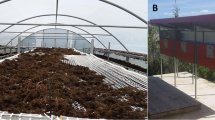Abstract
This article presents the first data on the contents of ash, organic carbon, proteins, lipids, major (Na, Mg, P, S, K, and Ca), trace (Li, Be, B, Al, Ti, V, Cr, Mn, Fe, Co, Ni, Zn, Ga, As, Se, Rb, Sr, Mo, Ag, Cd, Sn, Sb, Cs, Ba, Re, Hg, Tl, Pb, Bi, Th, and U) and rare-earth elements (Sc, Y, La, Ce, Pr, Nd, Sm, Eu, Gd, Tb, Dy, Ho, Er, Tm, Yb, and Lu) in two species of the brown algae (Laminaria digitata and Fucus distichus) from the bays of the eastern coast of the Novaya Zemlya Archipelago (the Kara Sea).

Similar content being viewed by others
REFERENCES
Bogolitsyn, K.G., Kaplitsin, P.A., Ulyanovskiy, N.V., et al., Comprehensive study of the chemical composition of brown algae in the White Sea, Khimiya Rastit. Syr’ya, 2012, no. 4, pp. 153–160.
Lobus, N.V., Elemental composition of zooplankton in the Kara Sea and the bays on the eastern side of Novaya Zemlya, Oceanology, 2016, vol. 56, no. 6, pp. 809–818.
Lobus, N.V., Drits, A.V., and Flint, M.V., Accumulation of chemical elements in the dominant species of copepods in the Ob estuary and the adjacent shelf of the Kara Sea, Oceanology, 2018, vol. 58, no. 3, pp. 405–415.
Lobus, N.V., Flint, M.V., Flerova, E.A., and Shcheglova, Y.V., Biochemical composition and energy content in the zooplankton of the Kara Sea, Oceanology, 2020, vol. 60, no. 6, pp. 778–786.
Nedospasov, A.A. and Poyarkov, S.G., Features of hydrophysical structure and water transfer in the bays of the Southern Island of the Novaya Zemlya, Sovrem. Metody i Sredstva Okeanol. Issled., 2021, vol. 1, pp. 120–124.
Saenko, G.N., Metally i galogeny v morskikh organizmakh (Metals and Halogens in Marine Organisms), Moscow: Nauka, 1992.
Khristoforova, N.K. and Chernova, E.N., Comparison of the content of heavy metals in brown algae and seagrasses, Dokl. Biol. Sci., 2005, vol. 400, no. 1-6, pp. 61–63.
Chernova, E.N. and Shulkin, V.M., Concentrations of metals in the environment and in algae: The bioaccumulation factor, Russ. J. Mar. Biol., 2019, vol. 45, no. 3, pp. 191–201.
Adeel, M., Lee, J.Y., Zain, M., et al., Cryptic footprints of rare earth elements on natural resources and living organisms, Environ. Int., 2019, vol. 127, pp. 785–800.
Gwenzi, W., Mangori, L., Danha, C., et al., Sources, behaviour, and environmental and human health risks of high-technology rare earth elements as emerging contaminants, Sci. Tot. Environ., 201, vol. 636, pp. 299–313.
Lobus, N.V., Arashkevich, E.G., and Flerova, E.A., Major, trace, and rare-earth elements in the zooplankton of the Laptev Sea in relation to community composition, Environ. Sci. Pollut. Res., 2019, vol. 26, no. 22, pp. 23044–23060.
MacMillan, G.A., Chételat, J., Heath, J.P., et al., Rare earth elements in freshwater, marine, and terrestrial ecosystems in the eastern Canadian Arctic, Environ. Sci. Process. Impacts, 2017, vol. 19, pp. 1336–1345.
Pooja, D., Kumar, P., Singh, P., et al., Sensors in Water Pollutants Monitoring: Role of Material, Singapore: Springer, 2020.
Postel, L., Fock, H., and Hagen, W., Biomass and abundance, in Zooplankton Methodology Manual, Harris R., Wiebe P., Lenz J., et al., Eds., London: Academic, 2000, pp. 83–192.
ACKNOWLEDGMENTS
The authors are grateful to the Leading Scientist of the expeditions, Academician M.V. Flint and the scientific staff, as well as the team of the R/V Professor Stockman and the R/V Akademik Mstislav Keldysh for their interest to our work and their assistance in conducting research.
Funding
The expeditionary research was performed in the framework of the State Assignment of Ministry of Science and Higher Education of the Russian Federation (IO RAS theme no. 0128-2021-0007). The data on the chemical composition of algae were obtained in the framework of the state assignment of Ministry of Science and Higher Education of the Russian Federation (IPP RAS theme no. 121041200194-7). The studies of the species composition and distribution of macrophytes were funded by the Russian Foundation for Basic Research (project no. 18-05-60070).
Author information
Authors and Affiliations
Corresponding author
Ethics declarations
The authors declare that they have no conflicts of interest.
This article does not describe any research using humans and animals as objects.
Additional information
Translated by I. Barsegova
Rights and permissions
About this article
Cite this article
Lobus, N.V., Udalov, A.A. The Chemical Composition of Brown Algae Laminaria digitata (Hudson) J.V. Lamouroux, 1813 and Fucus distichus (Linnaeus, 1767) from the Bays of the Novaya Zemlya Archipelago (the Kara Sea). Russ J Mar Biol 47, 407–412 (2021). https://doi.org/10.1134/S1063074021050096
Received:
Revised:
Accepted:
Published:
Issue Date:
DOI: https://doi.org/10.1134/S1063074021050096




